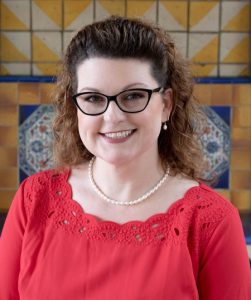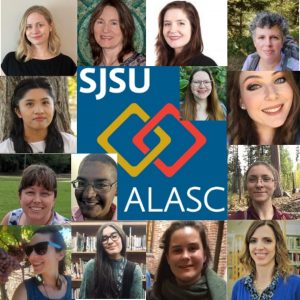
photo credit: Jocelyn Yamasaki/Caltech
In Pasadena, California, The Caltech Library, under the stewardship of University Librarian Kara Whatley, is pioneering a transformative journey towards creating a more accessible and equitable environment for its diverse community of learners and researchers. This journey encompasses a range of innovative initiatives, from enhancing physical spaces with shush booths to strategic partnerships with students aimed at improving service accessibility.
Conducted by DiAndra Reyes, the ALASC Blog Coordinator and processing intern at Caltech Archives, this interview delves into the specific actions and broader strategies Caltech Library is implementing to address these crucial areas in accessibility and equity. From technology enhancements to feedback collection methods and the personal investment in staff equity, Kara shares both the challenges faced and the successes achieved in continuing to make the library a welcoming space for all.
Learn more about the Caltech Library here.
DiAndra: What is your role at Caltech, and what is the role of accessibility and equity in the institution?
Kara: As University Librarian, I’m responsible for all of Caltech’s library and archives functions. Accessibility and equity are important in libraries and archives generally. It’s sort of baked into the core values of our profession. At Caltech, it’s something that I think has grown in importance over the last decade or so. Since I’ve been here, Caltech has established its first student accessibility service center, named one of its vice presidents as a chief diversity and inclusion officer, and really begun institute-wide initiatives in these areas. The work we’ve been doing in the library really fits in nicely with the institute’s overall vision for equity, inclusion, diversity, and accessibility at Caltech.
DiAndra: Are there any exciting projects related to accessibility and equity at Caltech Library?
Kara: We’ve been thinking a lot about the accessibility and inclusivity of our spaces, particularly the Sherman-Fairchild Library, the main library on campus. It’s open 24 hours a day, 5 days a week, and two shush booths were recently installed. Those have been really popular just in the few weeks we’ve had them for students who need less sensory input. We have also partnered with the Caltech Student Accessibility Student Services to provide checkout of accessibility technology. We know how to loan things, so having a partnership in that area made a lot of sense. We are also working with them to put together a proposal and execute a plan to create a sensory room in SFL. Those are the biggest accessibility initiatives we’ve got coming down the pipeline.
A couple of years ago, we redesigned our entire website, and accessibility was one of the principles that drove our thinking during the redesign. As far as equity goes, I’ve been thinking more about that in relation to our staff. So the position that you [DiAndra Reyes, Archival Processing Intern] have is a reflection of that thinking. It troubles me that so many of our processing archivists, particularly, are on soft money, which means as a professional, you’re always on the job market because that money is for a year or two years, and then you have to look for something again. I’ve seen and heard from archivists here at Caltech what that was like for them. So we’ve committed to not creating those kinds of temporary positions, but instead, when we do have soft money, having it be for an internship so that a student or a new professional is getting professional experience that can help them get a longer-term job. It’s also important to us that we help the interns build a professional network. So you may be thinking you’re getting rid of us, but you’re not. [laughs]
DiAndra: You’ve talked about how technology has played a role in enhancing accessibility within the library. Do you have anything to add to that?
Kara: We don’t have as much here as larger places do. I was actually talking to someone the other day about how challenging it can be for someone with lower vision to work in science areas. So, I think that maybe our population reflects some of the overall profession’s challenges, but other larger universities have adaptive technology rooms.
DiAndra: How do you gather feedback and input from library users, particularly those with diverse accessibility needs, to continuously improve services and resources?
Kara: So we’ve done a couple of user surveys. The most recent one we did was related to study spaces. We didn’t ask them what they thought of our spaces or how they used our spaces. Instead, we asked them their favorite places to study and why. What did they like about those places? So we could think about incorporating those things into our spaces. We also have a student population that is willing to advocate for itself. The student government is called ASCIT (The Associated Students of the California Institute of Technology). They were really great about getting feedback from students and sharing it with us. We’ve had some requests related to our physical spaces and requests for things like the library account patron data feed that we’ve been getting from the registrar hasn’t included lived name updates. So when we email students to tell them something is about to be due, we’re emailing them with the name that comes from the data feed, not their lived names. We didn’t realize we weren’t getting lived name information passed on to us. So, we’ve been working over the past couple of weeks on fixing this, at the request of ASCIT.
*lived name: a self-chosen, personal, or preferred name, instead of a legal name
DiAndra: What are some common challenges that the library faces in promoting accessibility and equity for both users and staff?
Kara: I think it would resonate with libraries everywhere to say that financial resources are a common challenge. We have to be strategic with the financial resources we have. What we’ve been doing has been trying to do a little each year. We’ve also been trying to think how small things can have a bigger impact. For example, we have very beautiful study tables in the 3rd-floor reading room in the Sherman-Fairfield Library, but they were put in when the building was built in 1997. There are power outlets on the floor, but not everybody can reach them. So, one of the things we did was buy power strips. We zip-tied them so that they would be on top of the tables. It’s helpful for people who can’t get down on the floor to the outlets. It’s also helpful for everybody who could potentially trip over your cords on the floor. It’s also just convenient for everyone. That was cheap and small, but it had a big impact on everyone, and I think that’s part of why accessibility and inclusion go together. When you make something accessible, you make it inclusive for your entire community. You make it better for everyone.
DiAndra: You just mentioned shush booths and power strips. Do you have any other success stories or impactful outcomes from your efforts to enhance accessibility and equity?
Kara: This is related to our larger student engagement issues, but I got to Caltech in the fall of 2019, and one of the things that struck me about how students were using our spaces was that they weren’t using our spaces. I was used to coming to libraries and seeing them filled with patrons.
DiAndra: What was the difference?
Kara: I think some of it was the culture here where students tend to study in their rooms and houses, but I also think that we weren’t inviting them into our spaces. So when we put together the events and programming committee, engaging students in our spaces was written into that committee’s charge. We do fun things like movie nights in the amphitheater. We engage the students in picking themes for our summer movie series. We engage them in picking particular movies that fit that theme. But we also have just little things during different times of the year. We had never done anything for Lunar New Year before, and now we have Lunar New Year snacks and design your own envelopes. It wouldn’t be a science and engineering library without dry-erase boards everywhere. So we got these rolling dry-erase boards. We’ll challenge them to draw their best dragon on them and things like that. Little things like that make a difference for students. Over the last two years, we’ve really seen a marked increase in the number of students using our space. If we give them boba for graduate student appreciation week, we get a chance to talk to them about the library and tell them about our services. We did this last year and had a hundred people in line at one point. If we provide snacks during finals, we get them to come into the library, and they realize our spaces are actually useful and usable by them. I think all of that together has changed the way students have been thinking about the library.
DiAndra: You’ve really changed the culture.
Kara: I hope so.
DiAndra: Lastly, for other institutions looking to prioritize accessibility and equity in their libraries, what practices or advice would you offer in your experience?
Kara: The first thing that springs to mind is don’t be afraid to think small. I think everybody sees the big challenges. We can build coalitions across campuses, fundraise, and address those big things, but small things will also have a positive impact on the students. We want to do something for the community we have now as well as build for the community we are going to have in the future.

